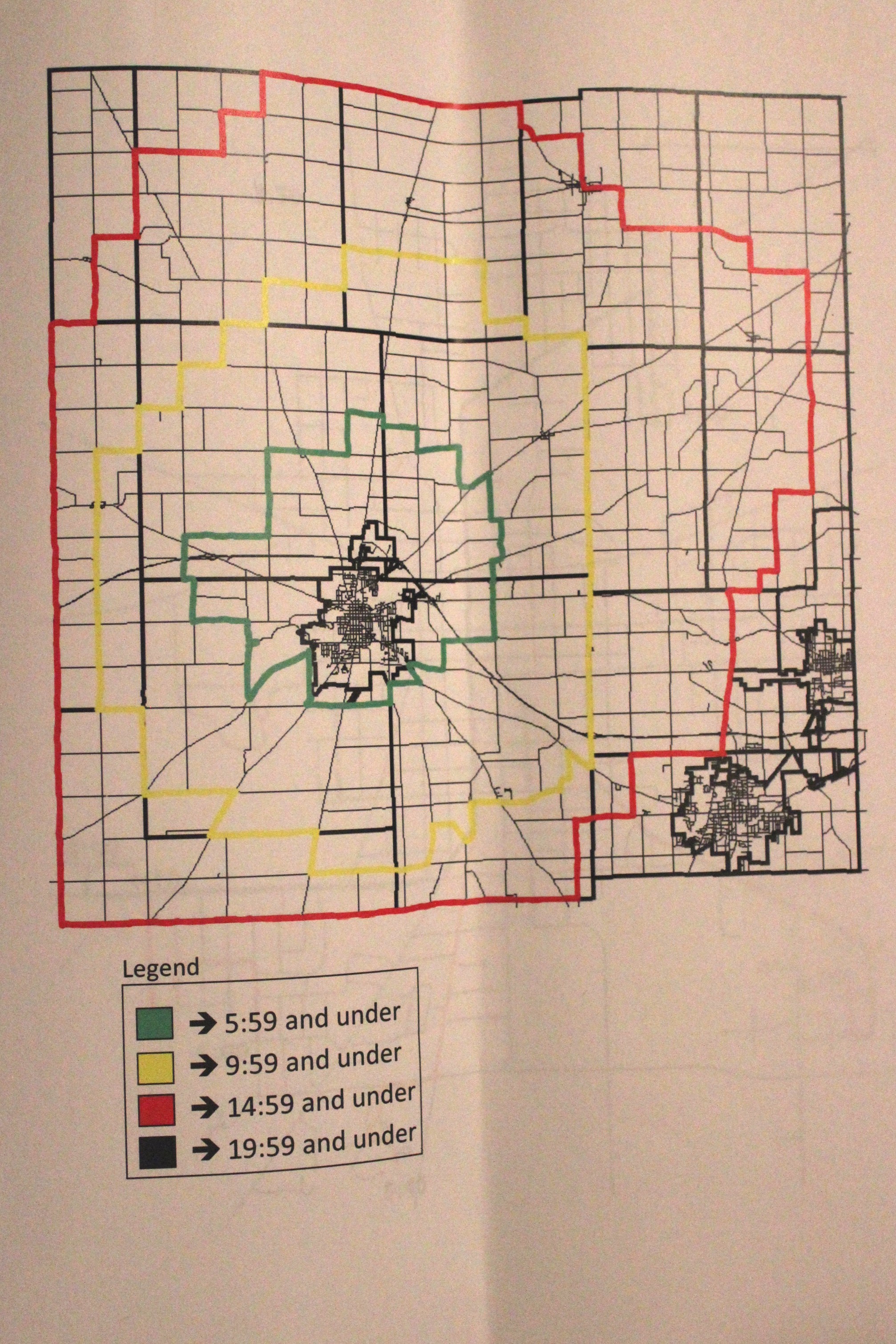By Bob Strohm
bstrohm@wbcowqel.com
With the Central Joint Ambulance District’s (CJAD) ambulance service provider contract set to expire in 2017, the owner of Life Support appeared before the CJAD Board to discuss future operations Wednesday night.
Tom Durbin, owner of Life Support Ambulance, spoke about the costs for the ambulance company to operate out of Crawford County.
“We are pleased with working with the board,” Durbin said. “Our goal is making sure that the community gets as good of service as possible. The staff is experienced with firefighters and EMT’s which gives us great personnel. The last 18 months we have integrated a good staff and equipment.”
“We have had about 2,000 calls per year and to have such few complaints and incidents says a lot about the workers,” Durbin added.
After opening his discussion to the CJAD, Durbin noted that he had conducted stat evaluations of the first year as well as expense reports.
“Jesse (Sipes) talks 200 plus runs per month, when we get refusals, cancelations, and fire standbys that result in no transport, which means no revenue is being made. In 2015, we transported 1,850 9-1-1 cases for gross billings of $1.6 million. The collections report expects the payback to be in the 50-percent range due to bad debt, being indigent, or uninsured. Seeing July 2015-July 2016 collection for 2015 came in at $648,910 or 39.9 percent, or 11 percent below collections expectations.”
Durbin continued his presentation to the board focusing on operating expenses.
“We began operating again in Mansfield in December,” Durbin said. “But over an 11-month period from January to November we had a total operating cost of $1.1 million with $284,000 in general and administrative expenses. Factoring other sources of revenue we are operating at a deficit of $515,000. Add in the general and administrative costs and we are well over $700,000.”
Durbin added that they want to continue to serve the community, but want to attempt to be as cost effective as possible.
“We are serving the community, and we want to serve as cost effective as possible,” Durbin explained. “We don’t have a problem subsidizing our other services to cover the deficit on the 9-1-1 contract. We could consider a tax-based revenue, but we understand that the CJAD wants to operate tax subsidy free. It is a costly business.”
Durbin went on to discuss a few possible solutions to help ease the financial burden on the ambulance service.
“I have a few solutions based on current operations. My first solution would be to reconsider the requirement of staffing a third crew. Some weekends or days we don’t need three staffed crews. It costs $335,000 per 24 hour crew annually. I would prefer to do that when we have more volume. Two-thirds of all runs come before noon, while one-third for the rest of the day. It is out of the ordinary to have three runs at once during the night. We would probably still operate with four to five crews during the day shift.”
“The other thing, and I wish the Bucyrus administration were (sic) here, we pay rent, maintenance and utilities which runs about $3,000 per month. The building is pretty much paid off by the city, we would like to agree to maintain the building, but have the city not charge the rent and utilities,” Durbin added. “If we could do those two I think it would help in reversing some of the red ink.”
Durbin added that in the cases when a third back-up crew would be needed during the evening, the CJAD could use mutual aid with the villages, cities and townships within the county, noting that at most it would average out to one or two times per month.
“I wanted you to have the real operating numbers. If the city wants to look at operating outside of the district, these would be the numbers,” Durbin said.
CJAD President Jamie Sherk stated that Life Support should have at least three crews operating in a window between 7 a.m. and 7 p.m.
Durbin added that industry-wide ambulance services have seen collection decline since the institution of the Affordable Care Act with insurance companies imploding.
“We used to collect a 20-percent co-pay from Medicaid, but the state stopped providing that as it went to help fund Medicaid with the roll-out of Obamacare.”
“Going forward we need to make changes, tweaking responders, and having Bucyrus’ EMS crew in more of a backup capacity,” Durbin added. “When we started, LifeStar’s numbers were not reflective of the actual numbers in the county.”
Sandusky Township representative to the CJAD Jason Long asked how many more runs per year would be needed to keep a third crew overnight.
Durbin answered saying that 900 more per year would be needed.
“Most runs come within the city, which about 50 percent of the paid revenue comes from,” Durbin said.
“What would happen if we lost the city?” Sherk asked. “Would you still be able to cover the rest of the district?”
“No. We wouldn’t be able to generate enough revenue to cover the rest of the county,” Durbin said. “We need to keep the city to maintain coverage with zero subsidy. The numbers are out, in order to operate with three crews 24 hours a day we would have to have a subsidy.”
When asked about the status of the lawsuit that Life Support was going through, Durbin provided an update.
“The other party offered a settlement, and as a result we have been working in Mansfield again,” Durbin said.
In Jesse Sipes’ report to the CJAD, Sipes provided a report for June and July, as well as the first half of 2016. Sipes reported that Life Support responded to 214 9-1-1 calls in June, as well as 243 in July. For the first half of 2016 the ambulance group responded to 1,295 calls of which 204 were refused.
The CJAD approved all variances with the exception of two over June and July.


